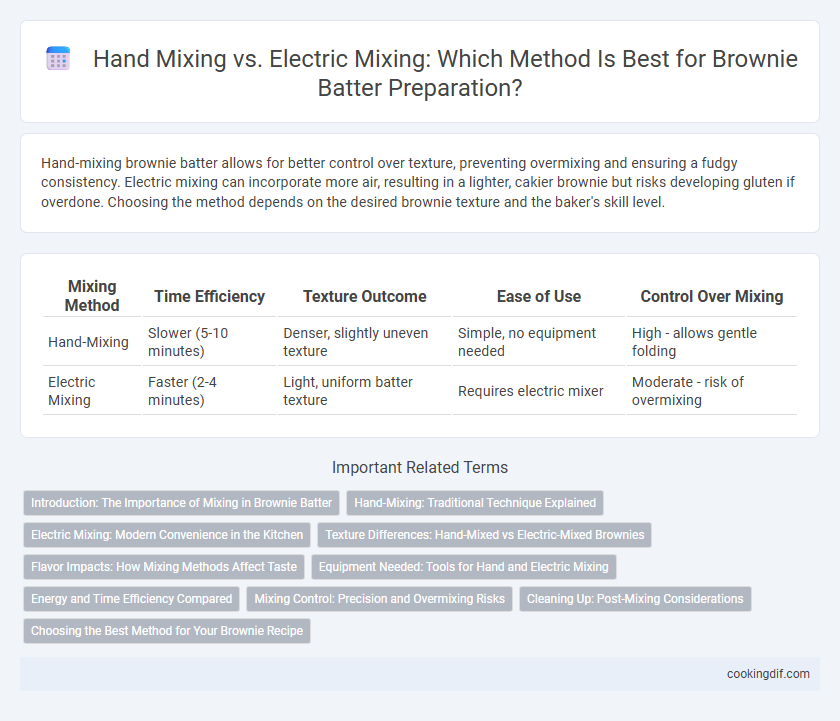Hand-mixing brownie batter allows for better control over texture, preventing overmixing and ensuring a fudgy consistency. Electric mixing can incorporate more air, resulting in a lighter, cakier brownie but risks developing gluten if overdone. Choosing the method depends on the desired brownie texture and the baker's skill level.
Table of Comparison
| Mixing Method | Time Efficiency | Texture Outcome | Ease of Use | Control Over Mixing |
|---|---|---|---|---|
| Hand-Mixing | Slower (5-10 minutes) | Denser, slightly uneven texture | Simple, no equipment needed | High - allows gentle folding |
| Electric Mixing | Faster (2-4 minutes) | Light, uniform batter texture | Requires electric mixer | Moderate - risk of overmixing |
Introduction: The Importance of Mixing in Brownie Batter
Proper mixing techniques are crucial for achieving the ideal brownie texture, as they influence gluten development and ingredient incorporation. Hand-mixing allows for gentle blending, preserving a fudgy consistency, while electric-mixing can introduce more air, leading to a cakier crumb. Understanding the differences ensures optimal batter preparation for the desired brownie outcome.
Hand-Mixing: Traditional Technique Explained
Hand-mixing brownie batter preserves texture by gently combining ingredients, preventing overmixing that can lead to dense, chewy results. This traditional technique allows for better control over batter consistency, ensuring evenly distributed cocoa and flour particles. Many bakers prefer hand-mixing to maintain a tender crumb and rich flavor profile in their brownies.
Electric Mixing: Modern Convenience in the Kitchen
Electric mixing offers consistent and efficient blending, ensuring a smooth brownie batter texture without overworking the gluten. This method reduces preparation time significantly compared to hand-mixing, making it ideal for busy kitchens and frequent baking sessions. Electric mixers typically provide multiple speed settings, allowing precise control over the batter's consistency and incorporating ingredients evenly.
Texture Differences: Hand-Mixed vs Electric-Mixed Brownies
Hand-mixed brownie batter typically results in a denser, fudgier texture due to slower incorporation of air, preserving moisture and creating a rich crumb. Electric mixing introduces more air, yielding a lighter, cakier brownie texture with a slightly more porous crumb structure. Choosing hand-mixing or electric mixing directly influences the brownie's mouthfeel and overall softness.
Flavor Impacts: How Mixing Methods Affect Taste
Hand-mixing brownie batter allows for gentle incorporation of ingredients, preserving air bubbles that contribute to a denser, fudgier texture and a richer chocolate flavor. Electric mixing can introduce more aeration, resulting in a lighter crumb and slightly altered taste due to increased oxidation of ingredients. Choosing hand-mixing often enhances the depth of flavor, providing a decadent and moist brownie experience.
Equipment Needed: Tools for Hand and Electric Mixing
Hand-mixing brownie batter requires minimal equipment, typically a bowl and a sturdy whisk or wooden spoon, making it ideal for simple setups or limited kitchens. Electric mixing demands more specialized tools such as a stand mixer or handheld electric mixer with variable speed settings to ensure consistent batter texture and thorough ingredient incorporation. Choosing between these methods hinges on available equipment and desired mixing precision, with electric mixers offering efficiency and uniformity in batter preparation.
Energy and Time Efficiency Compared
Hand-mixing brownie batter consumes minimal electricity but requires significantly more physical effort and time, often extending preparation by 5 to 10 minutes compared to electric mixers. Electric mixers optimize energy usage with a typical power range of 150 to 300 watts, completing batter preparation swiftly in 2 to 3 minutes, enhancing overall time efficiency. Choosing electric mixing balances energy consumption with faster results, while hand-mixing prioritizes zero electrical use at the cost of longer preparation time.
Mixing Control: Precision and Overmixing Risks
Hand-mixing brownie batter offers greater precision in controlling the mixing process, minimizing the risk of overmixing that can lead to dense or tough brownies. Electric mixers, while faster, often incorporate too much air, causing overmixing and negatively impacting the batter's texture and rise. Selecting hand-mixing techniques ensures better control over consistency and moisture retention for a tender, fudgy brownie.
Cleaning Up: Post-Mixing Considerations
Hand-mixing brownie batter requires minimal cleanup, typically involving only a single bowl and a whisk, which can be quickly rinsed and washed by hand. In contrast, electric mixers often involve multiple detachable parts, including beaters and splash guards, that need thorough cleaning to remove sticky batter residues. Choosing hand-mixing can reduce post-baking cleanup time, making it a practical option for simple and fast brownie preparation.
Choosing the Best Method for Your Brownie Recipe
Hand-mixing brownie batter allows better control over texture, preventing overmixing that can lead to tough, dense brownies, making it ideal for recipes emphasizing a fudgy consistency. Electric mixing accelerates batter preparation, ensuring even incorporation of ingredients, which benefits recipes requiring a lighter, cakey crumb. Selecting the best method depends on the desired brownie texture: hand-mixing for dense, chewy brownies and electric mixing for softer, airier results.
Hand-mixing vs Electric-mixing for batter preparation Infographic

 cookingdif.com
cookingdif.com